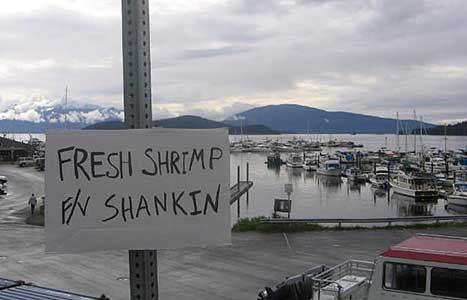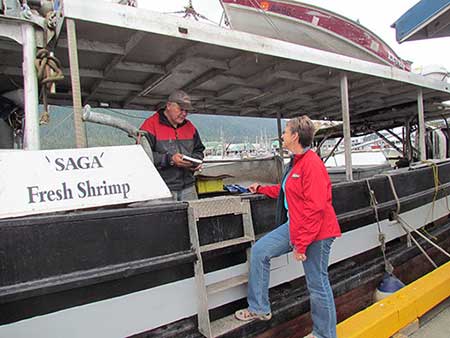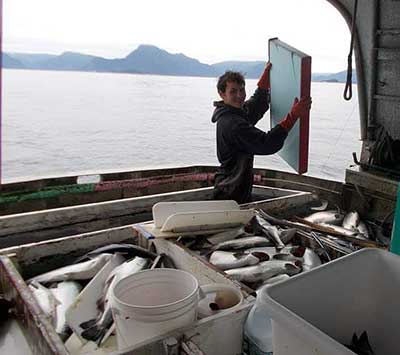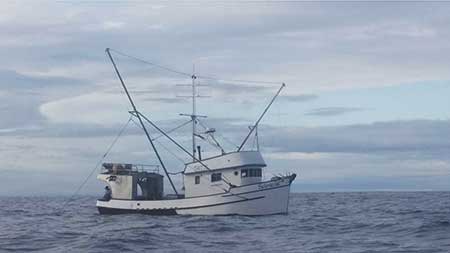Alaska Fish & Wildlife News
February 2016
Fresh Fish for Sale!
Catcher Sellers: How it Works

We’ve all seen those signs hanging up near local harbors advertising the sales of fresh Alaskan seafood. But what does it mean to be a fisherman who sells directly to the public from their boats at the dock?
These individuals are commercial fishermen who are called Catcher Sellers by ADF&G. A Catcher Seller not only can sell dockside directly to the public, but also can ship their fresh catch within the state of Alaska. By acting as a Catcher Seller commercial fisherman can provide fresh Alaskan seafood directly to the consumer, grocery stores, restaurants and local fish markets.
Catcher Sellers provide Alaskans and visitors the unique opportunity to meet the fisherman that caught the fish, see the vessel that harvested the fish and be able to purchase some of the freshest seafood that Alaska has to offer. These sales often times are sold at a price much lower than the consumer would pay at a retail store and the fisherman likely gets a price above what they would be paid by a licensed fish buyer. It’s a win-win for everyone.
ADF&G maintains a list of fisherman that are permitted by ADF&G to sell their own catch. That information is posted in real time on our website. Members of the public can access the list of permitted Catcher Sellers on the ADF&G website.
This list can be downloaded in the form of an Excel spreadsheet and then sorted by the user to select a certain community. You can also contact the Seafood Industry in Juneau to obtain a customized list by a certain species or geographic region.
Allowable Activities of a Catcher Seller
Commercial fisherman that are Catcher Sellers must obtain the proper permits and licenses from state and federal agencies, which may at first sound like a daunting task, but at the end of the day is a simple process and not expensive for the fisherman. The Catcher Seller permit type is defined in the ADF&G regulation 5 AAC 39.130. This regulation defines the allowable activities and reporting requirements associated with the commercial harvest of seafood. Catcher Sellers are specifically defined as “a commercial fisherman who sells or attempts to sell unprocessed fish that were legally taken by the catcher-seller

(A) to the general public for use for noncommercial purposes;
(B) for use as bait for commercial or noncommercial purposes;
(C) to restaurants, grocery stores, and established fish markets;
(D) by shipping the fish to a licensed buyer, processor, or exporter within this state;”
A Catcher Seller permit is needed so that ADF&G can assign a unique identifier so the department can associate the harvest with the individual fisherman as the person who sold the fish. Also, the Catcher Seller permit is associated with the individual, and not a particular vessel or fishery, meaning one Catcher Seller permit covers all activities for that fisherman, provided that they have a valid interim use or limited entry fishing permit from the Commercial Fisheries Entry Commission. Crewmembers are not eligible for a Catcher Seller permit. Other state and federal regulatory agencies also have a hand in the allowable activities of a Catcher Seller as well. For example, if the fisherman intends to sell IFQ halibut, they must also apply for a Registered Buyer permit for NOAA, which is free and simple to obtain. The Dept of Revenue requires a Fisheries Business License for any activities that include processing or exporting. This means that allowable activities are limited to only selling fresh unprocessed seafood within the state of Alaska if the fisherman has not applied for and received a Fisheries Business License from the Dept. of Revenue. The Dept. of Environmental Conservation may also have requirements, depending on what the fisherman intends to do with their catch.
The Application Process

The application process for a commercial fisherman to apply for a Catcher Seller from ADF&G is very simple. The ADF&G office located in Juneau is responsible for processing all of the permit applications. However, fisherman can send this application to the Juneau office however is most convenient for them. The paper application is two pages long and asks for basic demographic information, species that are intended to be sold and the area of the state in which the fisherman will operate. This application only takes a few minutes to complete and there is no charge for the permit. The application can also be submitted online, which also only takes a few minutes to complete. Applications can be submitted to the local area ADF&G offices and staff there will be happy to forward onto the Seafood Coordinator in Juneau for approval. Applications can be faxed to Juneau or scanned and emailed.
What Can I Expect After my Catcher Seller is Approved
Once ADF&G approves the Catcher Seller’s application, the commercial fisherman receives a permit approval letter, code plates and fish tickets. A code plate is an aluminum tag about the size of a quarter that is imprinted on a form provided by the department called a fish ticket. A fish ticket is a specific form that documents commercial harvest. Fish tickets vary for the different types of fisheries. There are fish tickets specific to salmon, herring, crab or shrimp, to name a few. Although fish tickets are a standardized form please check with local area offices for area and fishery specific reporting requirements.
Benefits of Catcher Sellers
Even though this application process may seem simple, only about 5% of permitted commercial fisherman apply for and receive their Catcher Seller permit. On an average over the last 10 years there are about 9,800 commercial fisheries permit holders and 500 permitted Catcher Sellers. Some advantages of being a Catcher Seller are the ability to ship fish from smaller communities, where a licensed fish buyer does not exist to a larger community where there is a market. This allows fisherman to commercially fish and sell their harvest when otherwise they would not be able to. This is good for rural Alaskan communities as well as the larger communities that get to have a continual supply of fresh Alaskan Seafood. For example, the Norton Sound red king crab fishery that occurs in the months when Norton Sound is frozen over. Commercial fishermen carve holes in the ice with chain saws and drop pots to catch delicious red king crab. By acting as Catcher Sellers those fisherman can then ship that crab to other areas of the state so that we can all enjoy fresh red king crab at a time when it would otherwise be unavailable. In Southeast Alaska, fresh winter king salmon from the salmon troll fleet is often shipped around the state, providing fresh salmon in the dark of winter.
Role of ADF&G

ADF&G is the primary regulatory agency of the activities of Catcher Sellers and we are here to help with any questions from the public, commercial fisherman and other state and federal agencies As one would imagine, commercial fisherman are resourceful and inventive. The activities of Catcher Sellers have changed over time, as the industry of commercial fishing has expanded into new waters, so to speak. Navigating these waters is always easiest with the right tools and resources. Please use ADF&G as a resource for information anytime. If anyone has any questions, please contact the Seafood Industry Coordinator in the Juneau office. We are happy to help and enjoy the inquiries. You can call ADF&G directly at (907) 465-6131, email shellene.hutter@alaska.gov or visit our website.
Shellene Hutter is a fisheries biologist based in Juneau
Subscribe to be notified about new issues
Receive a monthly notice about new issues and articles.
